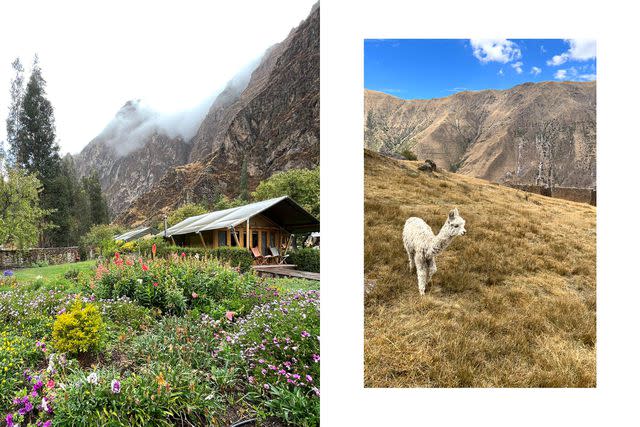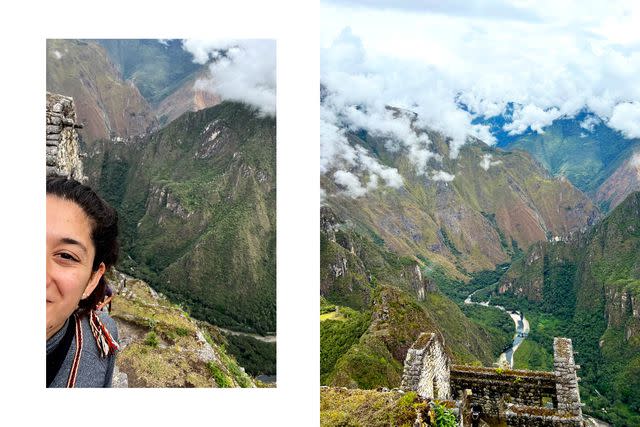I Went on My First Solo Hiking Trip in Peru — Here's How You Can, Too
What it's like in Peru right now, and how you can plan a hiking trip as a solo female traveler, according to someone who's done it.

Maya Kachroo-Levine/Travel + Leisue
I was sitting at 11,800 feet above sea level having a very earnest conversation with a baby alpaca. It was going quite well — we were really seeing eye to eye. I was outside the ancient ruins of an Incan town called Pumamarka, hovering above the town of Ollantaytambo in Peru’s Sacred Valley. In front of me: Andes peaks jutting into a blue sky with clouds that could’ve been painted on. Below me: vibrant green terraces punctuating the hillside. But really, I only had eyes from my pseudoruminant friend. We had the mountain to ourselves, save a few grazers 20 yards below, hanging with my guide, Porfirio (Porfy) Carbajal, who was thoughtfully charting our next move.
I came to Peru to see the new eco-resort Las Qolqas in Ollantaytambo. It opened in April 2021, but because COVID-19 closures and political unrest slowed tourism, I was still one of the first journalists to come see it from the United States. Airport protests on the ground in Lima postponed my original trip, which was set for February 2022, so I pivoted to a summer trip (well, winter in Peru) with more of a focus on trekking in the Sacred Valley.

Maya Kachroo-Levine/Travel + Leisue
The day before my hike to Pumamarka, I’d met Porfy, who owns local tour company Kuska Expeditions, in the center of Ollantaytambo to learn about its Incan and Quechuan history. It poured as we walked through the town, a series of low buildings with Incan-built stone foundations. The rain water gushed down amunas, or narrow stone canals that looked like gutters on a bowling alley, in a built-by-Incans-in-the-1200s sort of way. We talked about running, hiking, and Porfy’s Quechuan background. He’s an active member of the Quechuan Indigenous community — and in fact, as a kid, worked to maintain the very trail we descended from Pumamarka.
At nearly 12,000 feet, Pumamarka is actually quite a bit higher than Machu Picchu. And that’s why we started there. The idea was simple: the next day, we’d head to Machu Picchu and the elevation would feel like child’s play.
I spent the night before Machu Picchu cozied in the main house at Las Qolqas. The rain was falling hard outside, which was not helping my pre-hiking jitters, but the rotation of muña (Andean mint) tea and Pisco sours was. I sat at the bar after dinner — trout ceviche, freshly caught from the Vilcanota River rushing right through the property, doused in leche de tigre — with my book and a woven blanket. Then, I retired to my tented sanctuary and let the pounding rain lull me to sleep.
The next morning found Porfy and me running through the rain to catch the Inca Rail to Machu Picchu. We barely made it. Ollantaytambo is the closest train station to Machu Picchu — but it’s still about two hours away and not the most comfortable ride if you’re soaked. Undeterred, we spent the morning exploring Machu Picchu and the afternoon hiking the adjacent peak, Wayna Picchu. I have never been more thankful to have a guide. Could I have navigated the train and the dance of Machu Picchu ticketing myself? Sure. But I could not have navigated the trail — only 2.5 miles but with several vertical climbs on slick wet stones — on my own. It was well-marked, of course, though not well-populated in the subpar weather. So, to have someone in front of me, as I scrambled up vertical steps switchbacking over the Sacred Valley at 8,700 feet, was a huge relief.

Maya Kachroo-Levine/Travel + Leisue
I really couldn’t tell you how I got down from the summit of Wayna Picchu, when the rain let up, or whether I slept through the train ride back to Ollantaytambo. All I know is, by nightfall, I was slipping into the cedar hot tub back at Las Qolqas. The rain had finally stopped, but I could still hear the river rushing through the eco-resort as I soaked, then went to the main house to drink my weight in muña tea.
What to Know About Traveling to Peru Right Now
This might sound surprising given the political unrest that plagued Peru from December to March — repeatedly closing Machu Picchu and stranding travelers there — but it’s actually a good time to go. Allie Almario, a T+L A-List advisor specializing in Peru, says, “Things started settling down in March and Peru is now fully operational.” There are no lingering COVID-19 protocols and Almario, who plans trips at Premier Tours, says that it's rare to see political protests last as long as they did in the beginning of the year. She says this upcoming high season — our summer, Peru’s winter, from June to September — presents a unique opportunity because the country is ready to welcome tourists, but the crowds are only at 50 percent. That means Inca trail permits and train tickets to Machu Picchu are easier to come by, and tourist congestion is negligible. Almario has clients “coming and going regularly now, and for the most part, travelers don’t even realize there were previous issues.”
How to Plan a Hiking Trip Abroad As a Solo Female Traveler
Plan ahead, and don’t depend on others to bring the emergency provisions.
“Before you set off for your hiking trip, share your itinerary with at least one trusted contact and do your homework,” says Matt Berna, president and managing director of the Americas at Intrepid Travel. “Do thorough research about the place you're planning to hike, buy a topographical map, pack light, and be ready for weather changes.” Berna adds that for backcountry trekking or hiking by yourself in areas without cell service, a satellite GPS is a smart idea to “stay connected with friends and family and call for help if needed.”
Choose accommodations that will make you feel comfortable (whatever that means to you).
I was very partial to the small-scale eco-resort as a solo traveler. Las Qolqas has only 16 platform tents and one main dining room, plus a tiny spa with a cedar hot tub and barrel sauna, a fire pit, and a dome-like yoga pavillion. There’s one communal dining room, where I met most of the hotel guests, including two women about my age, who I joined for a drink one evening. Another night, guests and staff were invited to gather around a roaring bonfire for a ceremony, called Pago de la Tierra, celebrating the Quechuan new year. Mostly, though, Las Qolqas was a hotel where I was happy to spend time alone — sitting outside on my porch with a journal, leaning on the bar as the pair behind it shook Pisco sours, sprawling on the alfresco loungers in full view of the resort’s flower garden. (“It’s a really nice place to do nothing,” Luciana Martinez, the resort manager, told me when I checked in — and she was right.)
Consider working with a guide or joining a small-group trip.
My hotel set up my guide for me, and in general, if you’re working with a hotel that has great connections to local tour guides, you’re in good shape. Before booking your hotel, call and ask if they will help set up guided excursions — and whether it will cost extra. “From easier hikes to challenging treks, consider doing it with a small-group tour provider," Berna advises. "Go solo, but not alone — that’s our motto." Las Qolqas often works with Kuska Expeditions, and I found that working with a guide through the hotel made scheduling seamless throughout my trip. The hotel was in constant contact with my guide, and the expedition company arranged all of my transportation, including Inca Rail train tickets to Machu Picchu and entry tickets for the trails we hiked.
If spending on a luxury hotel and a guide for your trip is too expensive, you can find more affordable hotel options in the center of Ollantaytambo and book a guide separately. If you’re going to be hiking in remote areas and touring with a guide one-on-one, my biggest piece of advice would be to do a quick meet-and-greet with them before you travel to ensure your comfort. Finally, joining a small group tour is a great fit for solo travelers, mainly because, as Berna puts it, “We’ve done all the hard work for you. We’ve put years of research into creating hiking itineraries that visit the best bits of a trail and provide you with expert trail guides.”
For more Travel & Leisure news, make sure to sign up for our newsletter!
Read the original article on Travel & Leisure.

